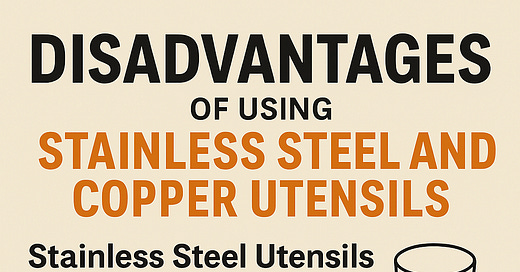Whenever you're ready, here are three great ways you can support us:
Promote yourself or your organisation by sponsoring this newsletter — we reach an engaged audience with a 30–40% weekly open rate. Leave a message or contact me directly at mrinmoy@majumdar.info.
Upgrade to a paid membership and unlock exclusive insights and benefits. Click here. (Click here to pay in USD)
Subscribe to the “I Tell Differently” Podcast on YouTube and stay connected with the latest updates of the I Tell Differently Newsletter. Click here.
Summery :
This article explores the hidden risks of using stainless steel and copper utensils for eating and drinking. It explains how precise alloy ratios (chromium, nickel, carbon, iron) in stainless steel prevent metal leaching and why deviations can cause skin, liver, and respiratory issues. It also warns that storing water in copper vessels beyond 6–12 hours leads to dangerous copper buildup in the body, offering simple checks and usage tips to stay safe.
“Hello and welcome to another episode of I Tell Differently. Today, I’ll explore the potential downsides of eating and drinking from stainless steel and copper utensils.”
1. Stainless Steel Utensils
Everyone assumes that stainless steel is completely safe for serving food and water. While it generally is, there’s a “magic ratio” for its alloy composition:
10–15% chromium
0.3% carbon
0.7% nickel
Remainder iron
When a stainless steel plate or glass follows these proportions, you can confidently use it without worrying about contamination.
However, if any of these elements exceed the recommended limits, trace amounts may leach into your food or water. Chromium and nickel, although essential in small doses, can become harmful when overconsumed. Excess exposure has been linked to:
Skin irritation and dermatitis
Liver and digestive issues
Respiratory problems, including potential carcinogenic effects on the lungs
How to Protect Yourself
Check the manufacturer’s information.
Visit the company’s website to confirm their alloy ratios.
If the details aren’t available online, contact the manufacturer directly.
Special Cases
Utensils intended for sour or salty foods may have adjusted ratios:
Up to 15% chromium for sour foods (nickel ≤ 0.3%)
Up to 18% chromium and up to 8% nickel for salty foods
Always verify these specifics before purchasing.
2. Copper Utensils
Copper is praised for its antimicrobial properties and trace-mineral benefits. Yet, storing water in a purely copper vessel for too long can pose risks:
After about 6–12 hours, copper begins leaching significantly into the water.
Continuous consumption of copper-rich water leads to accumulation in the liver, kidneys, and brain.
Long-term overexposure can cause liver cirrhosis, kidney damage, and neurological issues.
Copper also neutralizes sulfhydryl enzymes in the liver, leading to indigestion and abdominal discomfort.
Safe Usage Tips
Do not store water in a copper vessel for more than 6–12 hours.
Rely on your regular diet and mineral water to meet daily copper needs.
Reserve copper vessels for short-term storage only.
3. Key Takeaways
A balanced diet of rice, roti, pulses, fruits, vegetables, and mineral water already supplies your body with necessary chromium, nickel, carbon, iron, and copper.
Stainless steel and copper are beneficial only within specific limits; excess can lead to serious health issues.
Always verify alloy compositions before buying stainless steel utensils.
Limit water storage in copper containers to under 12 hours.
Thank you for listening to I Tell Differently. If you found this episode helpful, please like, share, and subscribe to our YouTube channel or newsletter. See you next week for another insightful discussion!
You can find me on Instagram / YouTube / Listly / Tumblr
This newsletter may receive affiliate commissions from some of the links given above/below. After deducting the honorariums, maintenance, and taxes for running this site, all the commissions will be deposited into NGOs and NPOs.
You may also like :
I Tell : My Life My Style YouTube Channel
Five All-Time Adventure Classics(Pay in USD)
Make your own WordPress membership site(AD)
This one is for urban Kishan(AD)
50 Business Ideas to open Start Ups in Sustainable Engineering(Pay in INR)
Publish your article in I Tell Differently Newsletter as a guest author
Ebook : 53 Ideas of Research Projects in Artificial Intelligence and Water Resource Development
Baipatra Very Short Term Course on Hydroinformatics Newsletter
How to open your own home page?(AD)
Podcast : Hydrology for Beginners
Learn in One Page : Artificial Intelligence and Water Resource Development













Share this post